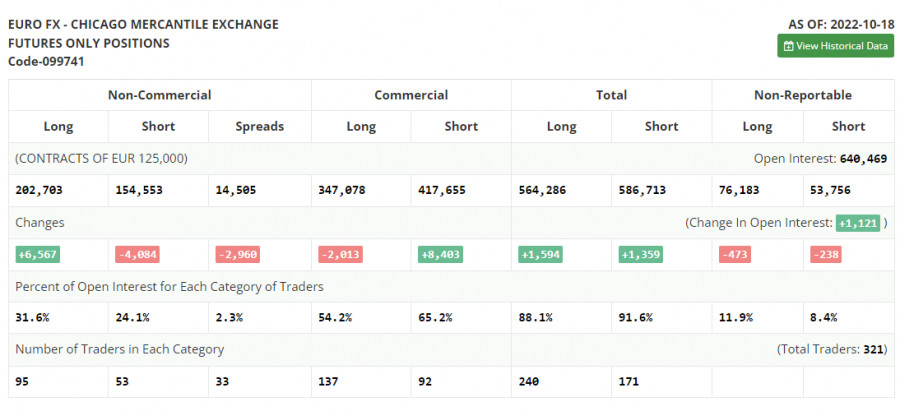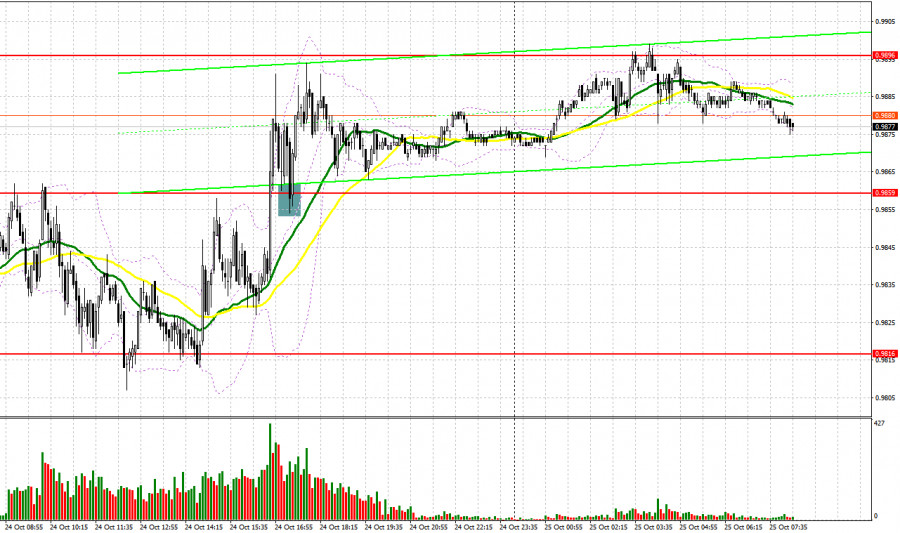
Yesterday, traders received several signals to enter the market. Let us take a look at the 5-minute chart to figure out what happened. Earlier, I asked you to pay attention to the level of 0.9832 to decide when to enter the market. A decline and false breakout of this level led to a buy signal, but the pair failed to show a rise. Weak data on the eurozone business activity capped the euro's upward potential. A breakout and reverse test of 0.9832 gave a sell signal. After the pair dropped by 15 pips, it managed to cope with the pressure. In the second part of the day, the euro surged amid sluggish data from the United States. A breakout and settlement at 0.9859 led to a buy signal. The pair managed to climb by more than 35 pips.

Conditions for opening long positions on EUR/USD:
First of all, let us focus on the futures market and the COT report. According to the COT report from October 18, the number of both long and short positions slumped. Demand for the US dollar is falling amid more and more signs of the economic recession caused by extremely aggressive monetary policy tightening conducted by the Federal Reserve. Last week, it became known that the housing market continued falling. This week, the US reported a significantly lower business activity in the services sector. This will hardly support the greenback since the demand for the euro is rapidly rising amid the ECB's promises to continue its hawkish policy to curb surging inflation. Notably, in September, the eurozone inflation slackened and remained below 10.0%. The COT report unveiled that the number of long non-commercial positions increased by 6,567 to 202,703, while the number of short non-commercial positions decreased by 4,084 to 154,553. At the end of the week, the total non-commercial net position remained positive at 48,150 against 37,499 a week earlier. This indicates that investors are benefiting from the situation and continue to buy the cheap euro below parity. They are also accumulating long positions supposing that the crisis will end soon and the pair will recover in the long term. The weekly closing price rose to 0.9895 from 0.9757.

Today, Germany is going to disclose a bulk of information that may negatively affect the euro. The data may prevent the single currency from climbing to new weekly highs. Traders should pay attention to the business expectations indicator, the current assessment indicator, and the Ifo business climate report. The expected drop in the indicators is likely to push the pair to the nearest support level of 0.9855, where there are bullish MAs. Only a false breakout of this level will give a buy signal. In this case, the price may hit a new resistance level of 0.9896. Notably, the pair has tested this level three times in the last 24 hours. A breakout and a downward test of this level will allow the pair to reach a new high of 0.9948, providing hope for a stronger rise to 0.9990. The farthest target is located at 1.0140, where it is recommended to lock in profits. If the price touches this level, the overall market situation will change. If the euro/dollar pair declines and buyers fail to protect 0.9855, panic may grow among traders. However, the market situation will hardly change dramatically. A false breakout of the next support level of 0.9816 will become a reason to buy the euro. It is also possible to go long just after a bounce off the support level of 0.9784 or lower – from 0.9747, expecting a correction of 30-35 pips within the day.
Conditions for opening short positions on EUR/USD
Sellers continue exerting pressure on the euro amid weak data from the eurozone. Recently, traders have been actively reacting to disappointing data from the US. There are several reasons for that. Investors more and more realize that the US economy is confidently slipping into recession. Today, bears should primarily keep the euro within the sideways channel. A false breakout of the nearest resistance level of 0.9896 will give a good sell signal. The pair may climb to this level thanks to strong data from Germany. A failure to settle at 0.9896 will lead to a decline to 0.9855. A breakout and settlement below this level as well as an upward test will give an additional sell signal with the target at 0.9816, where it is recommended to lock in profit. The pair may slide lower only amid strong data from the US. If the euro/dollar pair increases during the European session and bears fail to protect 0.9896, the price may jump. In this case, traders should avoid selling until the price hits 0.9948. A false breakout of this level will be a new entry point. Traders may also go short just after a rebound from the high of 0.999 or even higher – from 1.0040, expecting a decline of 30-35 pips.
Signals of indicators:
Moving Averages
Trading is performed above the 30- and 50-day moving averages, which points to a further rise in the euro.
Note: The period and prices of moving averages are considered by the author on the one-hour chart, which differs from the general definition of the classic daily moving averages on the daily chart.
Bollinger Bands
If the euro/dollar pair declines, the lower limit of the indicator located at 0.982 will act as support. A breakout of the upper limit of the indicator located at 0.9900 will lead to a rise in the euro.
Description of indicators
Moving average (moving average, determines the current trend by smoothing volatility and noise). The period is 50. It is marked in yellow on the chart. Moving average (moving average, determines the current trend by smoothing volatility and noise). The period is 30. It is marked in green on the graph. MACD indicator (Moving Average Convergence/Divergence - convergence/divergence of moving averages). A fast EMA period is 12. A slow EMA period is 26. The SMA period is 9. Bollinger Bands. The period is 20. Non-profit speculative traders are individual traders, hedge funds, and large institutions that use the futures market for speculative purposes and meet certain requirements. Long non-commercial positions are the total number of long positions opened by non-commercial traders. Short non-commercial positions are the total number of short positions opened by non-commercial traders. The total non-commercial net position is a difference in the number of short and long positions opened by non-commercial traders.